 The following chronology originally compiled by Hugh A. Halliday, for the National Museum of Man Mercury Series, Canadian War Museum Paper No. 6, National Museums of Canada, Ottawa 1975.
The following chronology originally compiled by Hugh A. Halliday, for the National Museum of Man Mercury Series, Canadian War Museum Paper No. 6, National Museums of Canada, Ottawa 1975.
Additional chronology items compiled by Dean C. Black, CD, CAE, SMP as part of the RCAF Association’s promotion of the centenary of the RCAF 1 April 2024
1883
August
Captain H Elsdale of the British army, using a camera mounted in a tethered balloon, photographed the barracks of the Halifax citadel, the first example of aerial photography in Canada. The Minister of Militia, the Honorable JPRA Caron, received an offer from Joseph L’Etoile to establish a balloon corps for the Canadian forces. The offer was not accepted.
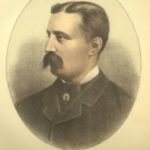
THE HONORABLE JOSEPH P. R. ADOLPHE CARON, B.C.L., Q.C.
1907
30 September to 1 October
Dr Alexander Graham Bell formed the Aerial Experiment Association at Halifax with Glenn Curtiss, an American motorcycle manufacturer, Lt Thomas Selfridge (US Army), JAD McCurdy, and FW Baldwin, two Canadian engineers.
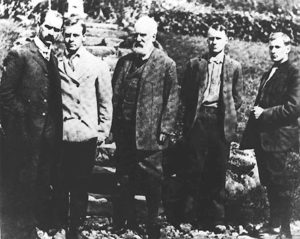
Glenn H. Curtiss (1878 – 1930), an American, renowned aeroplanes manufacturer who started by building motorcycles and was awarded the Scientific American Trophy for the first official one-kilometre flight in the Western hemisphere; Frederick Walker (Casey) Baldwin (1882 – 1948), graduate of the University of Toronto in mechanical engineering; Lieutenant Thomas Selfridge, an official observer of the United States government who came into the association upon Bell’s special request to President Theodore Roosevelt. John Alexander Douglas McCurdy (1886 – 1961), graduate of the University of Toronto in mechanical engineering, native of Baddeck and the fearless son of Bell’s friend, Arthur McCurdy;
1909
23 February
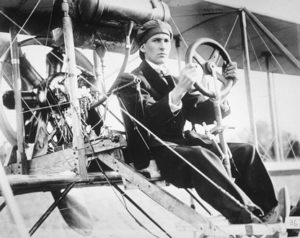
At Baddeck, NS, JAD McCurdy flew the “Silver Dart” biplane one-half mile over the ice-covered surface of Baddeck Bay. The “Silver Dart” was the fourth airplane manufactured by the AEA.
25 March to 15 May
Colonel RW Rutherford, the Master-General of the Ordnance, Canadian Department of Militia and Defence, proposed to the Militia Council that the department adopt a policy respecting aviation. The council decided on 15 May that it would assist inventors with men and equipment, but no funds were allocated.
June to August
In June, McCurdy and Baldwin shipped the “Silver Dart” to Petawawa, and on 2 August made four flights to demonstrate the military potential of their aircraft; on the last flight the biplane was wrecked. The “Baddeck No.1”, built by the Canadian Aerodrome Company at Baddeck, was then assembled and tested on 11 and 12 August before members of the Militia Council. In another demonstration flight on 13 August the “Baddeck No.1” crashed and was damaged.
1910
9 to 12 March
Major GS Maunsell, the Director of Engineering Services from Militia Headquarters, visited the Canadian Aerodrome Company at Baddeck, and witnessed several flights by McCurdy on the “Baddeck No.2.” McCurdy and Baldwin offered to sell their two “aerodromes” to the government for $10,000 and to instruct officers in their use, but the offer was not accepted. Officers of the Militia subsequently attempted to secure funds to support the CAC’s experiments, but the Cabinet refused to authorize such expenditures. Consequently, work at Baddeck ceased.
1911 – 1914
Lt Col (as he now was) GS Maunsell made repeated efforts to have the Department start an aviation section, but each attempt was turned down at the ministerial level. Canada thus had no military aircraft or personnel, and applicants wishing to sell aircraft or inventions were advised that no funds were available. During this period, at least four members of the Militia, Captain PS Benoit, Lieutenants BM Hay and RH Irwin, and Lance Corporal FS Brown, applied for pilot training, but were refused permission.
1914
4 August
Britain declared war on Germany. Constitutionally, at that time, this placed Canada in a state of war with Germany as well.
25 August
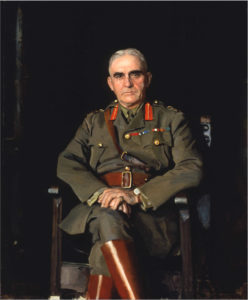
Colonel Sam Hughes, Minister of Militia and Defence, cabled Lord Kitchener, the British Secretary of State for War, asking if services of aviators were required. The War Office replied, on 31 August, that six expert aviators could be taken at once and perhaps some more later.
16 September
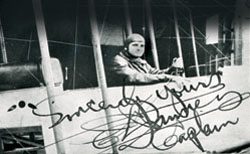
At Valcartier Camp, Col Hughes approved formation of the Canadian Aviation Corps, consisting of a provisional commander, EL Janney, with the rank of Captain, one other officer, and a staff sergeant mechanic, and authorised expenditure of not more than $5,000 on purchase of an aircraft.
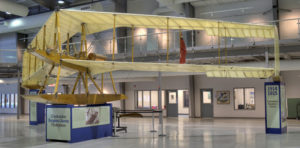
Burgess_Dunne Floatplane
The aircraft, a Burgess-Dunne biplane, was flown from Lake Champlain, Vermont, to Quebec City, and the three members of the Canadian Aviation Corps accompanied the First Contingent overseas on 30 September, 1914. Neglected, the biplane soon became a pile of “worthless junk”. Captain Janney resigned his appointment and returned to Canada in January, 1915; the second pilot, Lt WF Sharpe, went to France for a brief training course.
1915
4 February
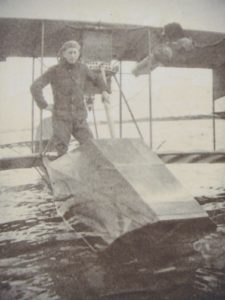
Lt William Frederick Nelson Sharpe was killed at Shoreham in a training flight – the first Canadian military aviator to give his life in the war. A tribute to Sharpe can be found at this link, here, near Prescott, Ontario.
7 February
The War Office asked the Canadian government to enlist candidates in Canada for the Royal Flying Corps.
April
The Admiralty asked the Department of Naval Service, Ottawa, to enroll applicants for the Royal Naval Air Service. Candidates for both the RFC and RNAS were required to secure pilot’s certificates, at their own expense, before being commissioned.
May
The third member of the Canadian Aviation Corps, Staff Sergeant HA Farr, was discharged from the CEF, “in consequence of flying corps being disbanded.”
10 May
Curtiss Aeroplanes and Motors Limited opened an aviation school at Toronto Island and Long Branch, under the management of JAD Mccurdy, to train candidates for the RNAS and RFC. By 7 December, when winter forced the suspension of flying, about 285 candidates had been enrolled, of whom 66 had graduated and 100 more had received partial training.
11 July
F/S/L HJ Arnold, flying as observer in a Henry Farman biplane, registered the guns of two monitors onto the German surface raider KBnigsberg, which was sunk. During the action the aircraft was shot down. Arnold was awarded the Distinguished Service Order, the first decoration made to a Canadian airman in the RNAS.
14 December
F/S/L AS Ince, RNAS, while flying as observer in a Nieuport biplane, shot down in flames a German two-seater seaplane off the Belgian coast. This victory was the first confirmed success credited to a Canadian airman.
19 December
Captain MM Bell-Irving, in a Morane Type N scout of No.1 Squadron, RFC, engaged three enemy aircraft between Lille and Ypres, destroying one in flames and driving off the others. He then evaded three more attackers and was about to open fire on another German machine when he was wounded by anti-aircraft fire. Captain Bell-Irving was awarded the DSO.
1916
12 May
The Curtiss Aviation School resumed training in Toronto. By the end of the year, it had enrolled 91 candidates for the RFC and RNAS; 63 graduated as pilots, and 24 received partial training.
1 to 2 October
Second Lieutenant WJ Tempest, flying a B.E.2c, shot down the Zeppelin L.31 over southern England in early morning darkness.
13 October to 21 December
Between 13 October and 21 December, the Imperial Munitions Board and the Canadian government evolved plans for the establishment of military flying training in Canada, backed by a factory to manufacture training aircraft.
28 October
Lt AG Knight and 2/Lt AE McKay of No. 24 Squadron, RFC, while on patrol near Pozieres, were attacked by 12 German fighters, led by the ace, Hauptmann 0 Boelcke. In diving on Knight’s aircraft, Boelcke, victor in 40 combats, collided with one of his own pilots, and was killed.
1917
25 January
An advance party of an RFC training brigade, headed by Lt Col (later BrigadierGeneral) CG Hoare, arrived in Toronto. In the next few months training camps were set up at Long Branch, Camp Borden, Deseronto (Mohawk and Rathbun), North Toronto (Leaside and Armour Heights) and Beamsville. By the Armistice in 1918, the RFC-RAF in Canada had recruited 16,663 cadets and mechanics; 3,135 pilots had been graduated (of whom 2,539 were sent overseas), together with 137 observers (of whom 85 proceeded overseas).
14 May
F/S/L R Leckie, RNAS, pilot of a Curtiss H-12 flying boat, shared with his crew in the destruction of Zeppelin L.22, shot down in flames off Terschelling.
2 June
Captain WA Bishop of No.60 Squadron, RFC, while making a solo dawn sortie in his Nieuport 17 scout, attacked a German airfield near Cambrai. As the German aeroplanes took off, he engaged them in succession and destroyed three before his ammunition was exhausted. He then flew home with his own aircraft damaged by ground fire. For this exploit, Captain Bishop was awarded the Victoria Cross. He had previously won the DSO and MC. By the end of August, 1917, Bishop had 47 enemy aircraft to his credit. In the spring of 1918 he won 25 more victories in 24 days, including five on 19 June, and was awarded the DFC.
14 June
The crew of an H-12 flying boat piloted by F/S/L BD Hobbs, RNAS, shot down Zeppelin L.43 in flames off Vlieland.
17 June
Flying a B.E.12 biplane, Lt LP Watkins destroyed the Zeppelin L.48, which was shot down in flames over southern England.
29 August
A reciprocal training scheme (first negotiated on 9 July) was concluded between the RFC in Canada and the Signal Corps of the US Army, whereby ten US squadrons were to be trained in Canada during the summer and autumn and two RFC wings were to be given accommodation for training in Texas during the winter. The first American cadets had arrived in Toronto early in July and training continued until October, when the move to Texas began.
1918
27 March
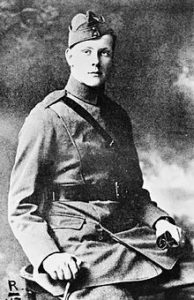
2/Lt Alan Arnett McLeod, pilot of an Armstrong Whitworth F.K.8 two-seater of No.2 Squadron, RFC, while attacking German troops with bombs and machine gun fire, was engaged and shot down in flames by enemy fighters. Despite five wounds, McLeod climbed out on the lower left wing and side-slipped until he crashed in No-Man’s Land. He then dragged his wounded observer away from the burning wreckage and, under heavy fire, carried him to comparative safety, suffering yet another wound while doing so. He was awarded the Victoria Cross, the second to be won by a Canadian flier.
1 April
The Royal Air Force was formed by an amalgamation of the Royal Flying Corps and the Royal Naval Air Service.
29 May
In conference with Canadian officials, the Secretary of State for the RAF agreed to the formation of a nucleus of Canadian squadrons within the RAF.
5 June
At the suggestion of the Admiralty, the Canadian government agreed to establish two air stations near Halifax and Sydney, NS, for anti-submarine operations. These were subsequently located at Eastern Passage (Dartmouth) and North Sydney.
24 June
Captain Brian A Peck, an instructor with the RAF in Canada, flew a Curtiss JN-4 (Can) from Montreal to Toronto with a bag containing 124 letters, the first airmail ever carried between two points in Canada.
5 August
Captain R Leckie, flying as observer in a de Havilland D.H.4, shot down Zeppelin L.70 in’ flames off the English coast. With his pilot he then damaged a second airship. This last Zeppelin raid against Britain cost the enemy the life of their airship commander, Fregattenkapitan Peter Strasser.
22 August
A Canadian Air Force Detachment was formed at the School of Technical Training, Halton, England, to train Canadian mechanics for the two proposed “all-Canadian” squadrons in the RAF.
5 September
Establishment of a Royal Canadian Naval Air Service was authorized to operate the two stations in Nova Scotia. Personnel were to be trained for lighter-than-air and heavier-than-air work. Until their training in the United Kingdom and the USA was completed, the US Naval Aviation Force undertook to operate the two stations and began anti-submarine patrols late in August.
27 October
After a distinguished career as a fighter pilot in Italy, Major WG Barker, DSO, MC, No.201 Squadron in France, was on his last operational flight before going to England, in a Sopwith Snipe. He shot down a German two-seater high above Mormal Forest, but was himself attacked by groups of enemy Fokkers, numbering in all about sixty. In an epic combat he destroyed three more of the enemy, raising his total number of victories to fifty. Major Barker, though wounded, crash-landed inside British lines. He was awarded a Victoria Cross.
11 November
The Armistice ended the First World War. During the conflict, some 20,000 Canadians served in the RFC, RNAS, and RAF; roughly 1,500 gave their lives; over
800 were decorated.
20 November
Nos.81 and 123 Squadrons, RAF (Nos.1 and 2 Squadrons, CAF) were formed at Upper Heyford, England, with all-Canadian personnel, as the embryo of a Canadian Air Force. The squadrons, commanded respectively by Major AE McKeever, DSO, MC, and Captain WB Lawson, DFC, moved to Shoreham in March 1919.
8 December
Organization of the RCNAS was discontinued; cadets under training were demobilized. Twelve seaplanes and four kite balloons, used by the air stations in Nova Scotia, were donated to Canada by the US government.
1919
25 March
No.1 Canadian Wing, CAF, was formed in Britain to administer the two CAF squadrons. Lt Col R Leckie, DSO, DSC, DFC, was appointed commander.
4 June
The government of the United Kingdom offered to donate aircraft to the Dominions; as a result, Canada received about $5,000,000 of equipment, including 100 aeroplanes, 14 flying boats, 12 airships, and six kite balloons, with hangars, sheds, spares, stores, vehicles, and other material.
6 June
The Canadian Parliament passed the Air Board Act, creating a body to control all aeronautics in the Dominion.
23 June
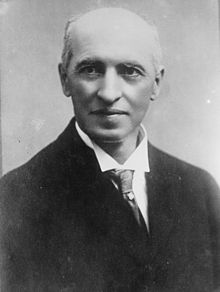
The first Air Board was constituted by Order in Council, comprising the Rt Hon AL Sifton (Chairman), (pictured above), OM Biggar (Vice-Chairman), the Hon SC Mewburn, Hon CC Ballantyne, RM Coulter, JA Wilson, and ES Busby.
3 November
Lt Col JS Scott, MC, AFC, was appointed Superintendent, Certificate Branch (later Controller, Civil Aviation) of the Air Board.
15 December
Lt Col R Leckie, DSO, DSC, DFC, was appointed Superintendent (later Director) Flying Operations in the Air Board.
22 December
The Air Board submitted to the Privy Council a memorandum proposing organization of a Canadian Air Force.
31 December
Air Regulations, drafted by the Air Board for control of aerial navigation in Canada, were approved by Order in Council.
1920
28 January to 5 February
No.1 Squadron, CAF, was disbanded in England on 28 January, followed by No.2 Squadron and No.1 Canadian Wing Headquarters on 5 February.
18 February
Formation of a Canadian Air Force was authorized by Order in Council, as a non-permanent, non-professional force and under the administration of the Air Board.
19 April
By Order in Council, a new Air Board was constituted, comprising the Hon Hugh Guthrie (Chairman), OM Biggar (Vice-Chairman}, Major General Sir WG Gwatkin, Lt Col R Leckie, Lt Col JS Scott, Capt W Hose, and E Deville. JA Wilson was named Secretary of the Air Board.
25 April

Major General Sir Willoughby Gwatkin, KCMG, CB, former Chief of the General Staff, was appointed Inspector General of the CAF with the rank of Air Vice-Marshal.
17 May
Lt Col AK Tylee, OBE, was appointed Air Officer Commanding, CAF, for a period of nine months with the rank of Air Commodore.
18 June
Captain HT Douglas (US Army Air Service) and Captain JA Le Royer, MC, (CAF) landed at Whitehorse, YT in a D.H.4 to make arrangements for a proposed American round-the-world flight. This was the first aircraft to land at Whitehorse, and Le Royer was the first CAF officer to operate in the Territories.
30 June
A provisional establishment of 1,340 officers and 3,905 airmen for the CAF was authorized by Order in Council.
5 July
Camp Borden was taken over from the Department of Militia and Defence to serve as a training centre.
31 August
“Regulations for the Canadian Air Force” were approved. Former officers and airmen of the RAF were invited to offer their services for duty with the CAF for not more than five weeks every year. A Canadian Air Force Association, established the previous June, was responsible to a considerable degree in administering the CAF, which was neither a permanent establishment nor an organization with embodied units. The Association, through provincial branches, maintained rosters of personnel and selected those required for 28-day refresher courses given biennially at Camp Borden.
1 October
Refresher training began at Camp Borden. By the end of the year, 86 officers and 111 airmen had completed courses, having logged 733 hours of flying time.
7-17 October
The first trans-Canada flight (Halifax to Vancouver) was completed in 49 hours, seven minutes flying time by relays of a Fairey IIIC seaplane, a Curtiss HS-21 flying boat, a Felixstowe F.3 flying boat, and three D.H.9A landplanes, piloted by W/C R Leckie, S/L BD Hobbs, and Captains JB Home-Hay, CW Cudemore, and GA Thompson. Average speed for the 3,341 miles was 68 miles per hour.
July to November
Air Board stations were established at Vancouver (Jericho Beach), Morley, Alta., Ottawa (Rockcliffe), and Roberval, PQ. Civil operations began in July, using HS-21 flying boats and D.H.9A and Avro 504 landplanes. Halifax air station was taken over from the Department of the Naval Service and used as a base for erection and repair of seaplanes.
Services carried out were forest fire protection patrols, reconnaissance survey and aerial photography; 398 flights were made for a total of 480.10 hours.
An experimental aerial survey of Ottawa was undertaken during the summer, using an Avro 504 and a Bristol F.2B – the beginning of this very important phase of the Air Force’s work. Another experiment was undertaken in September in co-operation with the Department of Agriculture to survey forest areas ravaged by insect pests. Operating from a temporary base at Lake Timiskaming, an aircraft carried Forestry and Entomological Branch officers on a complete survey over a large territory; 18 hours’ flying sufficed to obtain more information than could have been secured by several months’ ground work.
1921
During the year 375 officers and 835 airmen completed training courses at the “School of Aviation”, Camp Borden. There were 7,292 training flights and 313 communications flights, for a total of 2,847.45 hours.
In addition, army co-operation training exercises were carried out at Petawawa and Sarcee Camps and at Kingston, and with the Navy at Halifax. Flights totalled 148, or 138.55 hours. Such exercises at various army and naval bases became regular features of CAF and RCAF flying.
CAF Headquarters at Ottawa (OC W/C JS Scott) carried the names of 1,281 officers and 1,350 airmen on the rolls of 13 “paper” squadrons.
The Air Board conducted operations for nine departments of the Dominion government, (chiefly for the Department of the Interior) and for the governments of British Columbia, Ontario and Quebec. The major work continued to be forestry reconnaissance and fire protection (570 flights). In addition, there were 167 flights for communications and transportation, 164 for experiment and testing, 172 for reconnaissance and photography, and 69 preventive (anti-smuggling) patrols. Operations were carried out from seven Civil Government air stations at Vancouver, High River (in lieu of Morley), Victoria Beach (opened 1 July), Sioux Lookout {opened 20 May), Ottawa (Rockcliffe), Roberval, and Halifax (depot for repair and maintenance of flying poats). Aircraft used were HS-2L and F.3 flying boats, Avro sea- and landplanes, and D.H.4s.
11 April
While performing aerobatics in an Avro 504 at Camp Borden, S/L K Tailyour crashed and was killed. He was the first CAF officer to die in a flying accident.
30 November
The CAF ensign, identical to that of the RAF, was unfurled for the first time at Camp Borden. A separate ensign for the civil Flying Operations Branch was designed and approved but never flown.
1922
1 April
Refresher training at Camp Borden ceased. During the first quarter of the year, 81 officers and 245 airmen completed refresher courses. For the remainder of the year, training was restricted to eight officers and 80 airmen.
23 April
A D.H.4, en route from Camp Borden to London, ON, to conduct a photographic operation, crashed near Brantford, killing F/L Holland, the first CAF officer to die in the course of operational duties.
28 June
The National Defence Act was passed to incorporate in one ministry the Department of the Naval Service, the Department of Militia and Defence, and the Air Board. One comprehensive defence plan would now be possible instead of three separate programmes. Reorganization of the three Service departments was undertaken in preparation for amalgamation on a date to be fixed by proclamation.
29 June
In the Air Board, the first step was the consolidation of the Civil Operations Branch with the CAF in a single military organization. Hitherto, the CAF had no permanent staff, while the personnel of the Civil Operations Branch had been civil servants appointed by the Civil Service Commission. When necessary, they had been granted leave from their civil duties for service with the CAF. An Order in Council now provided for officers and men, employed as civil servants, to be granted temporary commissions or enlistments in the CAF. For the transition period a temporary establishment of 52 officers and 238 airmen was approved. The CAF was now placed under a Director, responsible to the Chief of the General Staff, for the control of both civil and military aeronautics. On 1 July, 1922, W/C JL Gordon, DFC, became Acting Director.
Reduction in estimates and reorganization of the Service caused drastic restriction of work during the year. There were only 1,784 flights (993.10 hours). All but 100 of the flights were for training at Camp Borden. The others were for testing, experiment, photography, and artillery co-operation with the Army at Sarcee and Halifax. Development of wireless telephone communication was carried out in co-operation with the Royal Canadian Corps of Signals.
Civil Government air operations increased to 1,210 flights (2,784.30 hours). Forest fire and survey patrols again predominated. Two sub-stations were opened at Norway House and The Pas, extending forest fire protection into more remote districts of Manitoba. In Ontario, bases were established at Whitney and Parry Sound for protection of the Algonquin Park area. Halifax (Dartmouth) remained in use as a repair base, and Ottawa (Rockcliffe) as a centre for experiment and photography. Part of Victoria Island at Ottawa was taken over as a Central Repair Depot for repair and maintenance work on flying boats and seaplanes.
Late in the year a station was opened at Winnipeg to serve as a winter base for the three Manitoba detachments.
A new feature in the year’s work was a series of flights to transport Indian agents paying treaty money at about 20 isolated posts in northern Manitoba and Saskatchewan. Such flights became routine operations in later years. Another innovation was a series of flights for the Department of Agriculture to investigate an outbreak of white pine blister rust in British Columbia.
18 July to 2 October
S/L RA Logan was attached to a Department of the Interior expedition into the north to investigate Arctic flying conditions. Sailing from Quebec, the expedition visited Baffin Land,. Bylot Island, Ellesmere Island, and North Devon Island. On his return, S/L Logan submitted a valuable report on the possibilities of aviation in the Arctic.
25 November
The air stations at Vancouver, High River, Victoria Beach, Ottawa, Roberval, and Dartmouth were officially redesignated CAF units and the air station superintendents became commanding officers.
28 November
The use of army ranks (lieutenant to colonel) alongside air force ranks was discontinued. Henceforth, officers were referred to only by air force titles, from pilot officer to group captain.
1923
1 January
The National Defence Act, passed in June, 1922, took effect and the Air Board ceased to exist as a separate government department.
15 February
His Majesty the King approved of the Canadian Air Force being designated “Royal Canadian Air Force”.
19 March
The uniform of the RAF, modified to include “Canadian” references, was adopted by the RCAF, although the dark blue uniform of the GAF remained in use until 1926.
23 April
The CAF motto “Sic Itur ad Astra” was discontinued and replaced by that of the RAF, “Per Ardua ad Astra”.
15 May
The first course of provisional Pilot Officers began training at Camp Borden. This was the start of a scheme to bring “new blood” into the Air Force by drawing potential officer aircrew from the universities and Royal Military College. The training course consisted of three summer terms. The nine PPOs of the first course were the first new pilots trained since the Armistice of 1918.
W/C JS Scott attended the RAF Staff College at Andover, the first of many Canadian officers to do so.
During the year, reorganization of the Air Force continued, the Force being administered as a Directorate in the Chief of Staff Branch of the Department of National Defence. A complete revision of the GAF Regulations of 1920 was undertaken. The strength of the Force on 31 March was approximately 45 officers and 195 airmen. The conversion of the Air Board branches into a single military organization had created a problem of securing sufficient skilled mechanics, as some of the men formerly employed by the Air Board preferred to return to civilian life.
In the first quarter of the year (1 January to 31 March) limited service flying, mainly training but including winter flying tests, was conducted at Camp Borden, High River, and Vancouver. Total service flying for the fiscal year, 1 April, 1923 – 31 March, 1924, was 681.30 hours out of a grand total of 2090.35 hours’ flying. The balance of the time was devoted to Civil Government and miscellaneous operations.
The RCAF was now responsible for all Civil Government air operations. Having pioneered in the development of many aerial services, the Federal government now began to withdraw from the provincial field, leaving it to commercial companies or provincial air services to carry on in Ontario and Quebec. The RCAF completed 1,422.50 hours flying on 867 flights during the calendar year, of which 750 hours were flown on forest fire patrol and survey in British Columbia, Alberta, and Manitoba.
Patrols began from a sub-base at Prince Rupert to suppress illegal fishing in the Queen Charlotte Islands area. The Dartmouth Air Station investigated, for the Post Office Department, the possibility of air mail service to the Magdalen Islands.
Other operations included aerial photography, preventive patrols to suppress liquor and narcotics smuggling, treaty money flights, white pine blister rust investigation, and experimental flying, principally testing air photographic equipment.
Air stations in operation were at Vancouver, High River (sub-base at Eckville and Pincher Creek), Winnipeg (sub-bases at Victoria Beach, Norway House, and The Pas), Ottawa (Rockcliffe and Victoria Island), and Dartmouth.
In June the first of eight Vickers Viking amphibians entered service – the first new aircraft acquired since 1919.
1924
1 April
Reorganization of the RCAF, started in 1922, was completed and on 1 April, the King’s Regulations and Orders for the Royal Canadian Air Force, and Pay and Allowance Regulations, approved by Order in Council on 4 March and 15 January, 1924 respectively, came into effect. The RCAF was now a permanent component of Canada’s defence forces. Under the new organization, the Force was composed of an Active Air Force (comprising a Permanent Active Air Force and a Non Permanent Active Air Force) and a Reserve Air Force. As of this date, the Permanent Force had a strength of 66 officers and 194 airmen (out of an authorized establishment of 68 officers and 307 other ranks). There were six “units” – Camp Borden, Ottawa, High River, Winnipeg, Vancouver, and Dartmouth Air Stations. Headquarters was under a Director, RCAF, responsible to the Chief of the General Staff. Branches were: Air Staff and Personnel (including Civil Government operations), Supply and Research, and the Secretary’s Branch which controlled civil and commercial aviation.
20 July to 12 August
S/L BD Hobbs, DSO, DSC, with a crew of three, photographed water routes in northern Manitoba and Saskatchewan from The Pas north via Pukkatawagan to Lac du Brochet at the head of Reindeer Lake, west to Ile-a-la Crosse, south to Prince Albert, and east to The Pas.
20 October
When a diptheria epidemic broke out in the Norway House district, aircraft from Victoria Beach flew anti-toxin to the area within six hours of receiving a request from the Department of Indian Affairs.
20 December
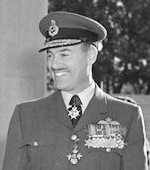
C. Roy Slemon would rise to the highest command positions in the North American Aerospace Defence Command (NORAD)
A wings parade for the first pilots fully trained by the RCAF in Canada was held at Camp Borden. W/C LS Breadner, DSC, presented flying badges to F/L FC Higgins, P/O BG Carr-Harris, and P/P/Os WC Weaver, CR Slemon, WJ Durnin, and CM Anderson.
Total Civil Government flying for the calendar year was 2,472 hours of which about 55 per cent (1,366 hours) was on forest patrol, primarily in Manitoba and Western Alberta. Over 40,000 square miles were photographed from the air for the Topographical Survey of Canada. In addition to regular duties of fishery and customs patrols, white pine blister rust surveys, and treaty money flights, the RCAF undertook to deliver mail by air daily to the Prince of Wales at his ranch near High River.
Service flying for the fiscal year, 1 April, 1924 – 31 March, 1925, totaled 1,615.57 hours, most of which was flying training at Camp Borden. A total of 48.05 hours was devoted to artillery observation and W/T communication with the Army and Navy at six locations.
1925
24 January
F/L GE Brookes and F/O AL Morfee, flying an Avro 504 from Camp Borden, attempted to photograph a total eclipse of the sun,
In a mid-air collision at Camp Borden, F/L JLM White, DFC, and F/O RH Cross were killed, the first flying casualties in the permanent RCAF.
25 July
New Dress Regulations for the RCAF were approved by Order in Council.
During the year RCAF units were given service designations. These were: No. 1 Flying Training Station at Camp Borden, No. 1 Wing at Winnipeg (with sub-bases at Victoria Beach, Norway House, and Cormorant Lake), Nos. 1, 2, 3, and 4 Squadrons (Operations) at Vancouver (sub-base Prince Rupert), High River (sub-bases Pincher Creek and Eckville), Shirley’s Bay (Ottawa), and Dartmouth, and No. 1 Depot at Victoria Island (Ottawa), comprising Main Workshops for winter overhaul of aircraft and equipment and the Central Stores Depot of the RCAF.
No. 3 Squadron moved from Rockcliffe to Shirley’s Bay, a seaplane base, early in 1925. This unit and No. 4 Squadron operated only during the spring, summer and autumn months. The stations were closed during the winter.
No. 1 Wing and the four squadrons (which assumed their new designations in July) were employed principally on Civil Government operations between May and October. In the winter they conducted training courses on various air force subjects.
Landplane training was given at Camp Borden and seaplane instruction was conducted at Vancouver. F/O A Carter, MM, and Cpl A Anderson began giving parachute training at Vancouver, High River, and Camp Borden. Seven officers and nine airmen were trained in 1925, and 35 practice jumps were made.
During the fiscal year the RCAF flew 5,111.47 hours, of which 2,593.11 hours were on service flying (mainly training) and the balance was on civil government air operations.
Paucity of funds continued to hamper the development of the Force, which was particularly handicapped by the presence of old D.H.4s, HS-2Ls and F.3s dating back to 1919. The first important step to remedy this situation was taken on 17 July, 1925, when the first Canadian Vickers Vedette three-seater flying boat was taken on RCAF strength, the first of 43 such machines to be acquired by the Force.
Late in 1925, tests began on the Canadian Vickers Varuna, a medium-sized flying boat, of which eight were eventually built for the RCAF.
Out of 2,518.36 hours flown by the RCAF on Civil Government air operations, roughly one-half (1,347.50 hours) were for forestry patrol, 60 per cent of it by No. 1 Wing with its three detachments in Manitoba. No. 2 Squadron at High River did nearly all the remaining forest fire patrols while No. 1 Squadron at Vancouver logged 16 hours’ flying in forestry work.
The year’s aerial photographic programme was restricted by bad weather to a total of 48,000 square miles (38,000 in Manitoba, 8,600 in Alberta, 1,140 in Ontario and Quebec, and 225 in Nova Scotia). Some 673 hours’ flying was devoted to this task. The principal areas covered were a large sector north of Edmonton, the Nelson River, and the line of the Hudson Bay railroad to Port Nelson and York Factory, which entailed the first RCAF flight to Hudson Bay.
Fishery protection patrols, conducted by a detachment of No. 1 Squadron based at Casey Cove, near Prince Rupert, covered an area from the Alaskan border to Cape Caution.
In co-operation with the Department of Agriculture, the studies of the white pine blister rust in British Columbia were continued. Studies of the wheat rust problem on the Prairies were undertaken.
Preventive service patrols for the Customs Department in British Columbia and flights for Indian Agents in Manitoba were also carried out.
In the course of these varied operations, four “mercy” flights were made to transport an ill mining engineer, an injured miner, an ill factor’s wife, and a sick Indian from isolated settlements in Manitoba.
The units employed on these operations (No. 1 Wing and Nos. 1, 2, 3, and 4 Squadrons) each had a strength of three to ten officers and nine to 47 airmen, a total of about 32 officers and 126 airmen. Aircraft used were HS-2Ls (Vancouver and Dartmouth), D.H.4s (photography at High River), Avros (fire patrols in Alberta and Manitoba), and Vikings (fire suppression in Manitoba). At Shirley’s Bay the Avro, Viking, Vedette, Varuna, and HS-2L aircraft were used for test, development, and photography.
1926
11 to 19 September
Mr J Dalzell McKee, a wealthy American flying enthusiast, accompanied by S/L AE Godfrey, MC, AFC, who served as navigator and second pilot, flew a Douglas OZB5 from Montreal to Vancouver, completing the 3,000 mile flight in 35.08 flying hours. RCAF facilities were used at several points en route. The crew averaged 4.02 hours flying time a day, the longest non-stop flight being of 7.14 hours’ duration. Stops were made at Ottawa, Lake Traverse, ·Sudbury, Orient Bay, Sioux Lookout, Swan Lake, Malachi Lake, Lac du Bonnet, Prince Albert, Lake Wabamun, and Vancouver. On 21 September, they flew from Vancouver to San Francisco (955 miles) in 9.17 hours. In appreciation of the assistance he had received, McKee donated to the Department of National Defence the Trans-Canada Trophy, to be awarded annually to persons outstanding in their contributions to Canadian aviation.
The composition of the RCAF, as noted for 1925, remained unchanged. No. 4 Squadron at Dartmouth was inoperative during the year due to lack of funds. Service flying (2,823.57 hours) showed an increase of about 10 per cent over the previous year. Seaplane training continued at Vancouver and landplane at Camp Borden. The first course for NCO pilots (six airmen) began training at Camp Borden. Two parachute riggers’ courses were given at High River, and one at Borden. Other courses included radio and W/T training, artillery co-operation, and refresher training.
The need for more efficient aircraft continued to be acute. The only modern service aircraft were two Armstrong Whitworth Siskin fighters on loan from Air Ministry. Winter flying tests were conducted on·these aircraft at Edmonton by No. 2 Squadron to determine the effect of extreme low· temperatures on their operation.
Total flying by the RCAF during the fiscal year was 5,229.10 hours.
Hitherto the programme of Civil Government air operations had been planned annually at an Inter Departmental Conference attended by representatives from the various departments concerned. On 3 May of this year, a Committee on Civil Air Operations was formally established by Order in Council to supervise and organize this work and make recommendations.
Lack of suitable aircraft and inadequate funds for the purchase of new types enforced a curtailment of the programme proposed for the year. Total civil flying decreased to 2,294 hours.
On forestry protection 1,132.43 hours were flown, 856 hours by No. 1 Wing alone over Manitoba and eastern Saskatchewan from sub-bases at Lac du Bonnet (replacing Victoria Beach), Norway House and Cormorant Lake. Although the season was abnormally wet, 256 fires were detected by air patrols. No. 2 Squadron (High River) was responsible for 261.45 hours of forest patrol work; No. 1 Squadron (Vancouver) contributed 24 hours.
The aerial photographic programme for the Topographic Survey increased to 1,116 hours, and the area photographed totaled 59,000 square miles. Once again most of the work (483 hours) was done by No. 1 Wing in northwestern Ontario and Manitoba. A special flight of two Viking aircraft was formed, entirely self-contained except for processing the negatives. From early June to late October it remained in the field, working from Victoria Beach, Lake St. Joseph, Sioux Lookout, Collins, Cormorant Lake, Norway House, Winnipegosis, and Lac du Bonnet. Early in September a second special photographic flight of two Vedettes was formed at Shirley’s Bay, flew to Lac du Bonnet, and worked in the field for six weeks.
Over 340 hours’ photography was logged by a third special flight from No. 3 Squadron (Shirley’s Bay). Operating a Varuna and two Vedettes from Larder Lake, ON and Senneterre, QC, they photographed 6,500 square miles of the Rouyn area.
Fishery patrols, previously an important duty of No. 1 Squadron (Vancouver), were all but cancelled. The squadron had available only two worn-out HS-2Ls of 1918 vintage. Patrols from Prince Rupert were suspended; one operation was completed in the southern part of the province.
Smuggling prevention patrols, white pine blister rust and wheat rust investigation, and treaty money flights called for about 85 hours’ flying. No. 1 Wing provided transportation for an electoral returning officer so that he could reach remote polls in the Nelson constituency of Manitoba.
1927
1 July
Hitherto Civil Government Air Operations and Civil Aviation had been under the control of the RCAF through Assistant Directors. The rapidly increasing importance of these activities made a re-organization of the government air services essential. They were, accordingly, divided into four branches within the Department of National Defence. The RCAF continued as a Directorate responsible to the Chief of the General Staff; it was the military branch of the air services and headed by G/C JS Scott, MC, AFC. Civil Government Air Operations were now divorced from it and placed under a separate Director, W/C JL Gordon, DFC. A third branch, Controller of Civil Aviation, was formed for the control of civil aviation, organization of airways and related duties. Its chief was Mr. JA Wilson. An Aeronautical Engineering Division, headed by W/C EW Stedman, QBE, was created to serve all three. The three new branches were responsible to the Deputy Minister. Although a separate Directorate of Civil Government Air Operations had been created, the RCAF continued to carry out these operations as well as much of the work of the other divisions. Indeed about one-half of its personnel were attached for duty with the other branches of the air services. It was proposed, however, to staff the Controller of Civil Aviation branch with civilians. Under the new re-organization the RCAF was left with only three service formations (squadron designations disappeared). Headquarters at Ottawa was organized into Director (with two Staff Officers for Personnel and Equipment) and Assistant Director (with four Staff Officers for Organization, Training, Operations and Intelligence, and Regulations).
RCAF Station Vancouver carried out seaplane training, winter training and combined naval-army-air operations and training. RCAF Station Camp Borden carried out landplane, parachute and technical training. Three· members of the first NCO pilots’ course graduated. Between May and July, tests were carried out at Camp Borden on a variable pitch propeller invented by Mr. WR Turnbull and fitted to an Avro 504K.
4 July
(The earliest beginnings of what could later be described as the Air Cadet movement)
A scheme for the technical training of boys, 15 to 18 years of age, approved on 5 Nov, 1925, was inaugurated at Camp Borden. Twenty boys attended the two months’ course; 16 qualified. For several years thereafter, “Boy” was a rank in the RCAF.
Only one combined army-air operation (3.15 hours at Sarcee) was conducted during the year.
Total RCAF flying was 4,303.20 hours. This included 289.55 hours on forest fire protection patrol and 16.20 hours on anti-smuggling patrol before the re-organization of the Air Services in July.
When the Air Services were re-organized, most of the RCAF’s air units were allocated to the CGAO Directorate. These included a headquarters, No. 1 Depot (Stores Depot and Workshops), the Photographic Section at Ottawa, and operational stations at Ottawa (Shirley’s Bay, for test and experiment, and photography), High River (sub-bases at Eckville and Pincher Creek), Winnipeg (sub-bases at Lac du Bonnet, Norway House, and Cormorant Lake, Manitoba, and two new sub-bases at Winnipegosis, Manitoba and Ladder Lake, Saskatchewan), and Dartmouth.
Total Civil Government air operations were 3,471.17 hours. Operations were carried out for nine departments of the federal government.
Forest fire patrol continued to be of primary importance and 106 fires were detected. Very unfavourable weather hampered the High River Station, but 193.05 hours were flown on patrol over 3,360,826 acres in the Bow River and Crowsnest Reserves. Operations by the Winnipeg unit steadily increased, the forest patrol area being extended from the Ontario border to the border of Alberta; 1,344.25 hours were consumed in protecting this vast expanse of 57,752,085 acres.
Aerial photography for the Topographic Survey covered 45,850 square miles. High River photographed 2,230 square miles in the Lacombe, Melfort and Saskatoon areas during 189.30 hours’ flying. Dartmouth did an equal amount (2,215 square miles; 157.09 hours), principally in the Shelburne area. Ottawa covered about 5,000 square miles (400 hours) on detached operations around Muskoka, Sudbury, La Tuque, Lake St Joseph and Roberval. The greater part of the photo work was once again done by the Winnipeg Station; unfavourable weather prevented the completion of more than 45 per cent of the year’s programme, but 36,456 square miles were photographed in 600.10 hours’ flying. Two mobile flights worked from Rainy Lake and Kenora in northwestern Ontario, Winnipegosis and Flin Flon in Manitoba, to Wood Buffalo Park in northern Alberta. The latter sector, extending along the lower Athabaska River to Lake Claire and along Slave River to the Alberta border, was the farthest north yet covered by the survey.
Two experiments, using a Keystone Puffer, were made in dusting crops and forests. A detachment from the Winnipeg Station flew 57.40 hours dusting wheat areas in Manitoba infected by black stem rust. Another detachment from Dartmouth Station flew 38.40 hours dusting forests in the Bras d’Or Lakes area to combat the spruce budworm insect pest. These experiments continued until the close of the 1930 flying season, using a Ford AT-6-AS in later tests.
On behalf of the Post Office Department, Ottawa Station made ten experimental flights between 12 September and 11 November to hasten delivery of trans-Atlantic mails. Outgoing mails were flown from Montreal to Father Point and incoming mails were picked up there.
On 24 June, authority was given to acquire an aerodrome site at St. Hubert, on the recommendation of Air Ministry officials. The original intention was to develop it as a base for trans-Atlantic airship services.
Aircraft in use for CGAO were Avro 504 land- and seaplanes, Vedette, Viking and Varuna flying-boats, D.H.4 landplanes, a Douglas M0-2B seaplane and Fairchild FC-2 and FC-2W monoplanes. More funds were now available for the purchase of new equipment, and during the year 109 aircraft and 51 engines were ordered for the Air Services.
17 July 1927 to 14 November 1928
In connection with the completion of the Hudson Bay Railway and its terminals, the Government organized a Hudson Strait Expedition, under the direction of the Department of Marine, to study ice conditions and navigation problems. The expedition tested the feasibility of using aircraft as an aid to navigation and the practicability of establishing air bases in the area. The RCAF contributed a party of six officers and 12 airmen, under the command of S/L TA Lawrence, with one D.H.60 seaplane and six Fokker monoplanes equipped with wheels, floats and skis. Sailing from Halifax on CGS Stanley and SS Larch on 17 July, the expedition reached Port Burwell on 27 July. Bases were established there, at Wakeham Bay and Nottingham Island. Regular air patrols began from the three bases on 19 October, JO September, and 11 October respectively, and continued until the middle of August, 1928. In all, 227 patrols were made for a total of 369.44 hours, and 2,285 photographs were taken.
Two aircraft were lost, but there were no casualties to personnel. The D.H.60 was wrecked at its moorings in a sudden storm. One of the Fokkers was abandoned when the pilot, lost in a heavy snow-storm, overshot Port Burwell and force landed on the ice of the Atlantic Ocean. F/O A Lewis, FS NC Terry and “Bobby”, their Eskimo guide, walked back to base after an absence of 13 days. There were two other force landings, on which crews were missing for one to nine days. It had been intended to fly the aircraft home at the end of the expedition, but damage to two of the machines caused the plan to be abandoned and the air component returned by ship in October, 1928.
1928
The increase in service and civil government flying which began in 1927 continued through 1928. Service flying totaled 6,793.45 hours, consisting chiefly of training at Vancouver (for seaplanes) and Camp Borden (for landplanes). Training of P/P/O aircrew was supplemented by direct entry RMC and university engineering graduates who were commissioned in the Permanent Force before starting their pilot training. Six such trainees began their flying courses in August.
Seven combined operations (126 hours) were completed with the Army, for reconnaissance, transportation and tactical exercises, and one operation (23 hours) with HMCS Vancouver of the RCN.
5 to 8 September
An experimental air mail flight was made, Ottawa to Vancouver, by S/L AE Godfrey, MC, AFC, and FS M Graham on a Fairchild seaplane. Stops were made en route at Lac du Bonnet, Ladder Lake and Edmonton. An attempted return flight ended when the seaplane crashed in the Peace River while attempting a force landing due to dense smoke from forest fires.
There was an even greater expansion in Civil Government air operations; flying hours jumped from 3,471 to 8,450.49. Approximately one-half of the RCAF personnel were employed at Ottawa, High River and Winnipeg Air Stations and with Photographic Detachments operating in the field for eight federal departments (Interior, Marine and Fisheries, Railways and Canals, Agriculture, Indian Affairs, Post Office, Mines, and Public Works).
Air patrols covered 64,534,563 acres of forest in Manitoba, Saskatchewan and Alberta, and flew 3,213.37 hours, divided between High River (706.32 hours, eight fires detected) and Winnipeg Air Stations (2,507.05 hours, 179 fires). In addition to the existing sub-bases and detachments, new sub-bases were opened at Ile-a-la-Crosse in northwestern Saskatchewan, and Grande Prairie, Alberta.
The Winnipeg unit also provided a detachment to transport personnel of the Department of Railways and Canals from the end of steel on the Hudson Bay Railway (near Deer Lake) to the new terminus at Churchill. The detachment also made coastal ice patrols between Nelson and Churchill. Flying time was 538 hours.
Miscellaneous operations included transportation flights by the Winnipeg Station for Indian agents, RCMP officers and other officials, and numerous flights by the Ottawa Station for transportation, training, testing of aircraft, instruments, wireless and cameras, and for air mail and air route investigation. The principal routes investigated were Ottawa-Minaki, Ottawa-Halifax, Montreal-Toronto, and Toronto-Buffalo.
During the year eight self-contained Photographic Detachments, controlled from Headquarters in Ottawa and attached to the nearest air station for stores and accounting, photographed 64,400 square miles. Each detachment consisted of two or three officers with three to six airmen and, with one exception, a navigator from the Topographical Survey; each had two aircraft (Fairchild seaplanes, or Viking or Vedette flying boats). The detachments flew 2,759.21 hours. No. 1 PD (attached to High River) operated in British Columbia where it completed six photo assignments and one customs patrol. Nos. 2, 3, and 4 PDs, (attached to Winnipeg) carried out 19 operations in western Ontario, Manitoba, Saskatchewan and northern Alberta (chiefly Lac Seul, Rainy River and Quetico areas in Ontario, Churchill River, Pelican Narrows and Lac La Rouge in Manitoba and Saskatchewan, and Slave River Lake Athabasca-Alberta boundary sector). Nos. 5, 6, and 7 PDs (attached to Ottawa) were engaged on 20 operations in eastern Ontario and Quebec (Lake Nipissing, Sudbury, Gatineau-Rouge-Mattawin Rivers, and Lac Archambault); and No. 8 PD (flying from Dartmouth, where now only a nucleus of personnel was maintained) did nine operations in the Maritimes. Ottawa Air Station also completed some photographic assignments.
The D.H.60 Moth was a new addition to the fleet of CGAO aircraft, replacing the veteran Avro 504s.
A summary of Civil Government air operations by units shows:
| Serial | Unit | Personnel (Officers) | Personnel (Airmen) | Aircraft | Flying Time |
| 1 | High River | 4 | 19 | 6 | 801.5 |
| 2 | Winnipeg | 25 | 72 | 26 | 3522.0 |
| 3 | Ottawa | 12 | 45 | 13 | 1367.4 |
| 4 | Photo Detachments | 17 | 34 | 17 | 2759.2 |
| 5 |
Sixteen Light Aeroplane Clubs organized during the year received assistance from the Department of National Defence. Each club received an initial issue of two light aircraft, and was paid $100 for each ab initio pupil who received a Private Pilot’s Certificate. Instructors for the clubs were given a Flying Instructor’s course at Camp Borden and 40 graduated during the next two years.
1929
For the third successive year there was a significant increase in the volume of service flying; 10,536.50 hours were reported. Flying training continued at Vancouver (seaplane), and Camp Borden (landplane), the only two air stations under the control of the RCAF. One combined operation with the Navy and six with the Army were carried out (178 hours’ flying).
In Civil Government air operations flying time rose to 12,240.59 hours. Approximately 5,800 hours were spent on forest fire patrols. High River Air Station reported 43 fires during the season’s work from sub-stations at Pincher Creek, Rocky Mountain House (Eckville), and Grande Prairie (about 1,294 hours). Winnipeg Air Station recorded 4,502.12 hours on forest protection service. The major bases utilized were Lac du Bonnet, Cormorant Lake, Norway House, Winnipegosis, Ladder Lake, and Lac La Ronge (in lieu of Ile-a-la-Crosse); patrols were also made from Berens River and Thicket Portage, MB; 325 fires were detected.
Photographic survey likewise expanded. Over 3,350 hours were flown, to photograph 74,655 square miles. As in 1928, eight Photographic Detachments were in the field. One completed eight operations in British Columbia, chiefly in the Parsnip River area. Four were active on 25 operations in northwestern Ontario, northern Manitoba and Saskatchewan, principally around Miminiska Lake, Ont., Flin Flon, Kississing Lake, Granville Lake and Churchill in Manitoba, and the Foster Lakes and Mudjatic River in Saskatchewan. Three more detachments worked in eastern Ontario, Quebec, and the Maritimes, particularly around Lake Nipissing, Rouyn, Senneterre, Doucet, Blue Sea, Moncton, and western Nova Scotia. In addition to 3,243.21 hours flown by the eight detachments a Mobile Photographic Training Flight, formed at Ottawa Air Station for instructional purposes, completed 110.45 hours on several operations.
The various air stations and detachments made numerous flights to transport officials of the Civil Aviation Branch, treaty money parties and other government officials. In addition Ottawa continued its important test and development work, and made a number of investigation flights during the winter along the Ottawa-Montreal-Saint John-Halifax air route.
The operational base at Ottawa was moved from Shirley’s Bay, where it had been since 1925, to Rockcliffe, its original site. Station Vancouver was transferred to the CGAO Directorate; like Dartmouth, where a nucleus was still maintained, it was used as a base for photographic detachments.
An important development this year was an expansion of National Research Council activities to include aeronautical research. A wind tunnel and other facilities were being constructed.
New types brought into service were the Avro Avian, Curtiss-Reid Rambler, and the Canadian Vickers Vancouver.








